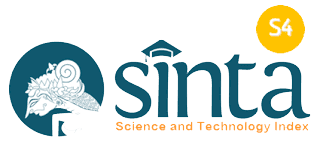Developing Biak-Numfor as a National Tourism Magnet: Strategies for Tourism Destination
(1) Politeknik Pariwisata Makassar, Indonesia
(2) Politeknik Pariwisata Makassar, Indonesia
(3) Politeknik Pariwisata Makassar, Indonesia
(4) Politeknik Pariwisata Makassar, Indonesia
(*) Corresponding Author
DOI: https://doi.org/10.26858/pdr.v6i2.47664
Abstract
Keywords
Full Text:
PDFReferences
Aliah, N., Dirawan, G. D., Mukmin, A., Haedar, A. W., & Samad, Y. (2019). Tourism Destination Development Potential Tongke-Tongke Mangrove Forest Sinjai Regency, Indonesia. International Conference on Public Organizatiion (ICONPO) IX.
Antara, M., & Sumarniasih, M. S. (2017). Role of tourism in economy of Bali and Indonesia. Journal of Tourism and Hospitality Management, 5(2), 34–44.
Asriwandari, H., Susanti, R., & Kadarisman, Y. (2021). Securing the Zamrud National Park Based on the Traditional Fisherman Community. Sosiohumaniora, 23(2), 281. https://doi.org/10.24198/sosiohumaniora.v23i2.31933
Basorudin, M., Afifah, N., Rizqi, A., Yusuf, M., Humairo, N., & Nugraheni, L. M. S. (2021). Analisis Location Quotient dan Shift Share Sektor Pariwisata sebagai Indikator Leading Sector di Indonesia. ECOBISMA (Jurnal Ekonomi, Bisnis Dan Manajemen), 8(1), 89–101. https://doi.org/10.36987/ecobi.v8i1.1855
Carayannis, E. G., Ferreira, F. A. F., Bento, P., Ferreira, J. J. M., Jalali, M. S., & Fernandes, B. M. Q. (2018). Developing a socio-technical evaluation index for tourist destination competitiveness using cognitive mapping and MCDA. Technological Forecasting and Social Change, 131(May 2017), 147–158. https://doi.org/10.1016/j.techfore.2018.01.015
Ely, P. A. (2013). Selling Mexico: Marketing and tourism values. Tourism Management Perspectives, 8, 80–89. https://doi.org/https://doi.org/10.1016/j.tmp.2013.07.003
Hariyono, U. S., & Akib, H. (2019). The spread out strategy of the main weapons tool system of the Indonesian Air Force in the region of the Republic Of Indonesia. Austral: Brazilian Journal of Strategy and International Relations, 8(15), 117–130.
Kartajaya, H. (2005). Attracting tourists, traders, investors: strategi memasarkan daerah di era otonomi. Gramedia Pustaka Utama.
Kostadinović, I., & Stanković, S. (2021). Organizational Learning and Innovation in the Tourism Industry as a Basis for Creating Value for Tourists. Economic Themes, 59(1), 153–172. https://doi.org/10.2478/ethemes-2021-0009
Lin, P. M. C., Fan, D. X. F., Zhang, H. Q., & Lau, C. (2019). Spend less and experience more: Understanding tourists’ social contact in the Airbnb context. International Journal of Hospitality Management, 83, 65–73. https://doi.org/https://doi.org/10.1016/j.ijhm.2019.04.007
Mainolfi, G., & Marino, V. (2020). Destination beliefs, event satisfaction and post-visit product receptivity in event marketing. Results from a tourism experience. Journal of Business Research, 116, 699–710. https://doi.org/https://doi.org/10.1016/j.jbusres.2018.03.001
Muhtasom, A., Ab, A., & Ab, A. (2019). Kahayya Village as a Priority Destination for Rural Tourism Development Policy in Bulukumba Regency. Jurnal Ad’ministrare, 6(1), 1. https://doi.org/10.26858/ja.v6i1.9432
Ojo, B. Y., & Yusof, R. N. R. (2019). Edu-Tourism Destination Selection Process in an Emerging Economy. Journal of Tourism Management Research, 6(1), 45–59. https://doi.org/10.18488/journal.31.2019.61.45.59
Pan, Y., Fu, X., & Youcheng Wang. (2020). How does travel link to life satisfaction for senior tourists? Journal of Hospitality and Tourism Management, 45, 234–244. https://doi.org/https://doi.org/10.1016/j.jhtm.2020.07.013
Rachmawati, I., & Dewi, M. A. (2020). A Note for Indonesia’s Border Diplomacy in Tanjung Datu, West Kalimantan. Jurnal Hubungan Internasional, 9(1), 1–14. https://doi.org/10.18196/hi.91158
Said, F., Salam, R., Akib, H., & Baharuddin, A. (2017). An Analysis of Tourism Visit Trend. 149(Icest), 34–36.
Yousaf, S., & Xiucheng, F. (2018). Halal culinary and tourism marketing strategies on government websites: A preliminary analysis. Tourism Management, 68, 423–443. https://doi.org/https://doi.org/10.1016/j.tourman.2018.04.006
Article Metrics
Abstract view : 125 times | PDF view : 15 timesRefbacks
- There are currently no refbacks.
Copyright (c) 2023 Arnie Arief, Muchammad Makkah Arief, Ali Muhtasom, Masri Ridwan


































